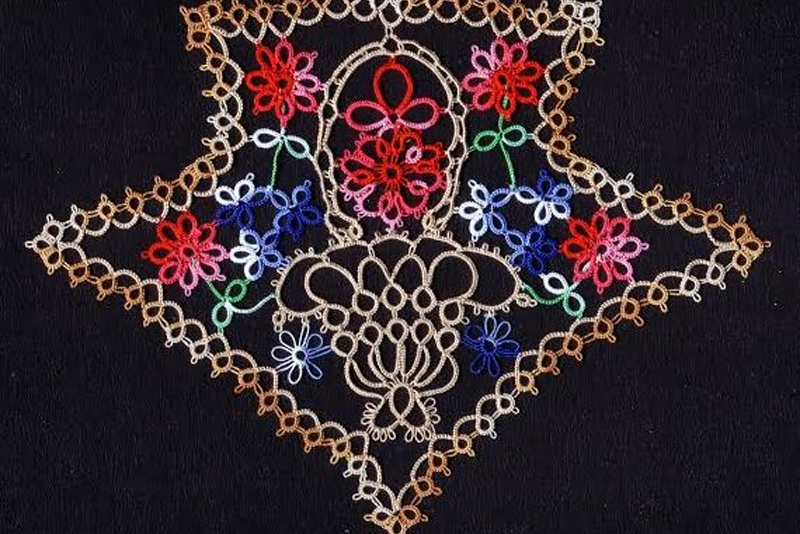
I had only been tatting seven years when the Jones book was published. Nearly three decades later this book remains a standard reference in my personal tatting reference library. It not only has patterns in the traditional style but also three dimensional pieces, jewelry and whimsical figures for note cards. It contains snippets of history about the origins of tatting, mostly conjecture (and misinformation but accepted at that time.) It also shows the use of the purling pin (a pin on a ring depended from the thumb usually) to create the picot and the method of a needle used as a shuttle.
I consider her section on how to tat (pages 18 - 34) to be a serious reference tool for all tatters. It shows six basic methods of tatting; The Reverse Riego, the Traditional Method, The Loop Method, The Direct Method, Wrong-Way Tatting, and Needle Tatting.
The Reverse Riego Method is named after Mlle Riego. In this method the first half stitch lays the loop over the left hand instead of the right hand which is holding the shuttle and proceeds with the under movement. The second half stitch allows the loop to dangle freely and the shuttle enters over the ring from the side or bottom.

The Traditional Method has the loop laid over the right hand which is holding the shuttle. Tension is applied to this loop by the raising of a finger, the middle finger or the pinkie finger being the most often used. Over/under's proceed as normal.

The Loop Method, similar to the Riego Method, has the loop laid over the left hand. Here the action of the shuttle entering and leaving the ring area occurs in the space between the forefinger (used in the pinch) and the middle finger (used to relax and tension the thread causing the half stitch to form.)
The Direct Method treats the shuttle in the manner that we treat the tatting needle today. The shuttle carries the core thread. A left facing loop is made with the fingers and the shuttle slides through the loop. Thus, the core thread itself is not manipulated to make the "flip" or "transfer" which is the classic method of making the half stitch. A right facing loop is made with the fingers next and the shuttle also passes through it, thus completing a double stitch on the carrying cord.

Wrong Way tatting is the term used by Jones to describe the wrapping method we use and call "split ring tatting" today. Here the ring is formed on the left hand and held taut, never relaxing. The shuttle takes the thread over/under without causing the flip. The half stitches are set firmly on the ring thread. Any picots will face into the ring instead of outward. To close this ring is it necessary to pull on the ball thread. The Jones example shows a double core thread. Today we do this with one core thread, beginning a ring in normal tatting, stopping part way, and using a second shuttle to wrap the ds onto the core thread. Here, too, we must return to the thread providing the core to close the ring.

Needle Tatting is a method to create tatting without manipulating the thread to create the "flip" or "transfer" of the loop. Here the core thread is loaded on the needle. Left and right facing loops are made with the fingers and the needle slides through these loops which once tightened.

Of course, the needle may also be used as if it were a shuttle in special circumstances.

Except in very rare instances, it is not necessary to adjust patterns to accommodate any particular style of tatting. If the pattern says to make a ring/chain 5 - 5. You simply create the 10 double stitches with a picot in the middle in whatever fashion you use to tat. It is the lace that is produced that matters, not how you got there.
Both the Direct method and Wrong-Way tatting method create the ds without flipping the stitch. In Direct Method, the method is the same as needle tatting, you loop the thread and slide it over the shuttle/needle and down onto the carrying cord. Wrong-Way tatting #5 is also wrapping the ds onto the carrying cord, but it requires that the carrying cord/ring core thread be accompanied by a second thread, from the ball. It is the ball thread that closes the ring since the wrapped ds cannot be drawn into a circle by the shuttles which wrapped them.
A circumstance when adjustments to the methods used would be necessary is the single shuttle split ring (SSSR). The SSSR creates a ring in the normal tatted fashion with flipped ds for half the size needed. The ring is then drawn partially closed with SH 1, and one or more rings are stacked upon it in the same fashion. When the point has been reached, you work wrapped ds over the bare thread or the exposed ring core thread all the way down the row of half-closed rings.
7 Methods of tatting: http://www.bellaonline.com/articles/art37566.asp
Tatting vs wraping: http://www.bellaonline.com/articles/art28248.asp
Here's the latest article from the Tatting site at BellaOnline.com.
Beaded Cluny Necklace - Dagmar Pezzuto
A new cluny pattern by Dagmar Pezzuto. This necklace uses the hanging cluny technique.
http://www.bellaonline.com/articles/art4493.asp
Please visit tatting.bellaonline.com for even more great content about Tatting.
To participate in free, fun online discussions, this site has a community forum all about Tatting located here -
http://forums.bellaonline.com/ubbthreads.php?ubb=postlist&Board=39
I hope to hear from you sometime soon, either in the forum or in response to this email message. I thrive on your feedback!
Have fun passing this message along to family and friends, because we all love free knowledge!
Georgia Seitz, Tatting Editor
http://tatting.bellaonline.com
One of hundreds of sites at BellaOnline.com







